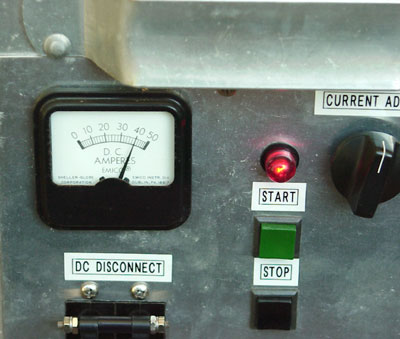Taming Lester 9
Two weeks ago during some nice weather, I decided that it was time to take the EV Rabbit out for a spin to loosen up the brake calipers and get some lubricant on the axle bearings. I dug the Pusher out from under it's winter wraps, put a charge on the engine starting battery and fired it up.
Took the car and Pusher down to the road where I disconnected the trailer and left it at the end of the driveway. Put seven miles on the car in electric-only mode, not much of a trip, but enough for a test, and about as much as the batteries were up to without some exercising discharge/charge cycles to wake them up.
Used the Pusher to help the car up the steep part of the driveway where traction is a problem, then hauled out Lester for some real world charging. With an actual discharge on the EV battery pack, I was easily able to hammer 40 amperes into the cells, adjusting the charge rate control for as much or as little as desired. Here's the proof, an honest 40 amperes into the battery:

When I finished the rebuild of the charger, I put the metal cabinet back into place, enclosing the transformer and wiring. I noted that one of the aluminum panels had been replaced with an obviously homemade sheet steel panel. Perhaps the original aluminum panel had been damaged or lost? Whatever, I didn't care, as the replacement panel was made well enough, and had a nice painted finish on it to prevent rusting.
Well, now I have a new project, replacing the panel. An aluminum panel is needed because the steel panel reacts to the magnetic field produced by the transformer during high current charging. It vibrates at 60 Hz with a terrifying buzz, making the charger seem as if it is about to explode! I eventually had to remove the screws and run the charger without a side panel as it was driving me nuts!

This photo is interesting for a couple of reasons. for one thing, it's heavily (and rather badly) photoshopped to lessen the contrast between sun and shadow, making it possible to see into the carport. More notable is that it shows almost all of my EV gear in one shot. There is the EV and Pusher, Lester, the hood of the Electrak and it's charger (more on this later), my electric lawnmower (for trimming where the Electrak can't get), and the BIOBZL Rabbit is thrown in for good measure. I didn't stage these things for a photo, or even think about it when I took the picture, the stuff was all just out in one place at the same time.
Last week, I did some mowing with the Electrak, then put it on the charger to fuel up. The charger is a modified Todd Power Source charger that has the internal connections set for 36 volt output. I was in the garage doing something and heard a nasty crackle sound and looked out in time to see the Todd burst into a column of smoke and flames! Damn, fried it again! These chargers are prone to flame out for no particular reason. I used to take them in for repair as a side job, but after having too many of them blow up in my face during testing, I quit.
Anyhow, until I can get the Todd repaired, I used Lester to charge the tractor. I had to set the charge control fairly low because of the voltage mismatch, but it did a fine job of replenishing the electrons.
Now, about that undersized output wiring. I figured that the maximum output of the Lester would be 40 amperes, so #8 gauge wire would be large enough. Unfortunately, I didn't calculate for the fact that the charger doesn't put out pure direct current, but pulsating DC. This wouldn't normally be a problem, but the batteries in the traction pack act like a filter capacitor, one that is at the end of a resistor in the shape of two wires. What I find is that the #8 wire gets warm, even hot enough to make the fairly stiff plastic insulation nice and pliable. The 50 ampere Anderson connectors that make the connection between the charger and the batteries get pretty warm too.
So, what I need to do now is increase the gauge of the wire to handle more current. I measured 20 amperes of AC current on the wiring while charging at 18 amperes of DC current. Adding these together gets me 38 amperes, about as much as the wire is capable of.
I'm also going to look into providing some filtering in the form of a large capacitor inside the charger to try and smooth out some of the AC component before I try to send the voltage to the batteries. It's doubtful that I can filter it very much, particularly when charging the Electrak at 36 volts, but any reduction in the AC ripple will be an improvement.
Original material ©1996-2025 Mr. Sharkey | All rights reserved
